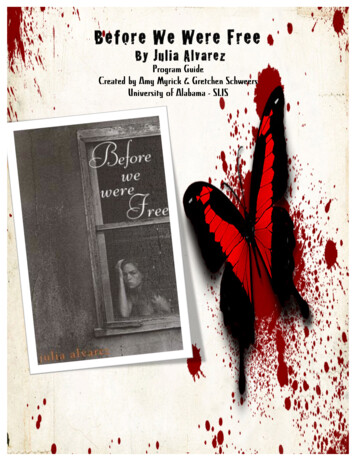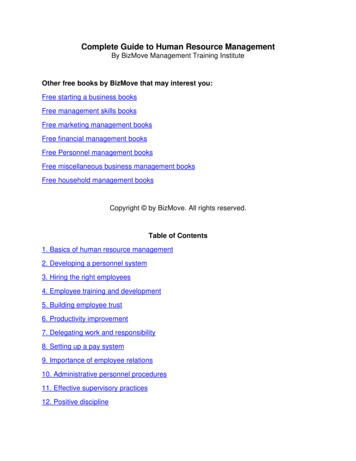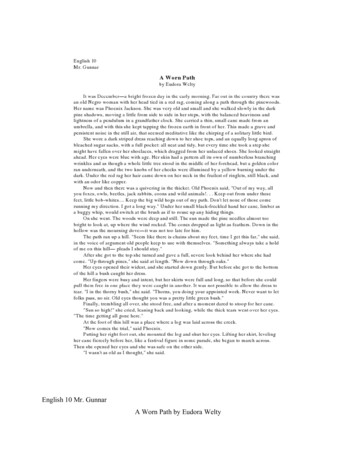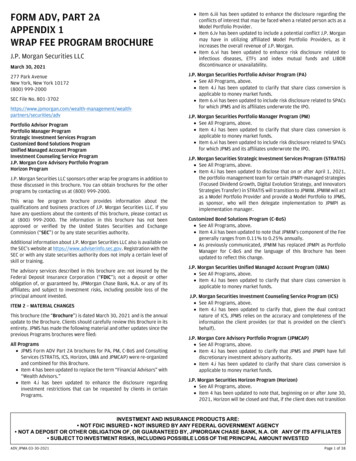
Transcription
Before We Were FreeBy Julia AlvarezProgram GuideCreated by Amy Myrick & Gretchen SchweersUniversity of Alabama - SLIS
Before We Were FreeAlvarez, Julia. Before We Were Free. Laurel Leaf: New York. 2004. 167pps.Grades 7-12.Book Summary:During the year 1969, there were many ofchallenges and changes for one family. Before she wasfree, Anita and her family lived in the DominicanRepublic. General Trujillo rules with fear and cruelty.Anita goes to school to learn to speak English, and to bea good citizen. Plus, she’s beginning to grow up, and twovery different boys begin to notice her. It’s a time wheneveryone speaks in whispers, and girls are afraid to beseen. It’s unsafe to be heard or noticed by thePresidente. People are starting to disappear, and rumorsare heard of them being put in prison and tortured. Thenwhen Anita’s father begins to meet other men to plan away to remove Presidente Trujillo, Anita’s fears come true.Could her father really be planning to murder the General?Then, Anita’s father is taken, and she is forced to hide in a neighbor’s closet. TheGeneral’s Secret Police are watching and waiting! Hopefully, it can soon be arranged forher to escape to America. Julia Alvarez tells a wonderful coming of age story in a tryingtime. This would be a great book to compare with The Diary of Anne Frank. Alvarez’sbook is better suited to teen readers in grades 7-12. Some of the content might bedisturbing to younger readers.Meet the Author Julia Alvarez:Sites: g/wiki/Julia rez-Julia.html
More Great Books:Bedggood, Ginnie and Ilana Benady. Dominican Republic CultureSmart! The Essential Guide to Customs and Culture . Kuperard: NewYork. 2010. 168pps. Grades 3-12.Summary: Learn all about the land, history, people, and customsof the Dominican Republic.Augustin, Byron. The Dominican Republic A-Z. Children’s Press: NewYork. 2006. 40 pps. Grades 2-7Summary:Provides readers with information related to the geography, history,culture, and people of the Dominican Republic.Alvarez, Julia. In the Time of the Butterflies. Algonquin Books:New York. 2010. 352 pps. Grades 7-12.Summary:Expanded from one of the stories in How the Garcia Girls LostTheir Accents, this novel set in the Dominican Republic duringthe rise of the Trujillo dictatorship describes the three Mirabelsisters (las tres mariposas) who were murdered for theirparticipation in an underground movement to overthrow thegovernment.Alvarez, Julia. How the Garcia Girls Lost Their Accents. LaurelLeaf: New York. 2006. 288 pps. Grades 7-12.Summary:Based upon the experiences of Alvarez and her sisters, thiscoming of age novel follows the four Garcia sisters as they movefrom the Dominican Republic to the United States and attempt toacculturate. This sensitive novel successfully captures theimmigrant experience of teens from a variety of cultures.
Gonzalez, Christina Diaz. The Red Umbrella. Knopf Books forYoung Readers: New York. 2010. 299pps. Grades 3-12Summary: Following the events that led up to Operation PedroPan, this coming of age novel depicts a teenaged Lucia and heryoung brother as they watch their beloved Cuba change underthe Castro regime. Daily Lucia watches as her life crumbles andbecomes more dangerous until her parents ship her and herbrother to the United States. Gonzalez successfully captures theexperience of family separation and the ultimate sacrifice thatparents will make to save their children.
Activities:Introductory game/activity (ice-breaker)Sample Card:Materials: Printed Bingo CardsPen or PencilDirections: Print Bingo cards on cardstock. Participants mix and mingle to locate asmany people to sign their cards as possible. Once a person gets 5 signatures in a rowthey shout “Bingo”! A small prize can be awarded to the first person who wins. This is awonderful way to get to know people!Find someone who HAS BEEN TO ADISNEY THEMEPARKHAS WORN ACASTDISLIKESCHOCOLATEHAS MORE THAN2 BROTHERSIS LEFT HANDEDIS A VEGETARIANPLANTED THEIROWN GARDENNAME BEGINSWITH MHAS BEEN TOTHE OCEANSPEAKS MORETHAN ONELANGUAGELIKES COUNTRYMUSICHAS NEVERWATCHEDAMERICAN IDOLFREE SPACEIS WEARINGGLASSESHAS A RED CARPLAYS A MUSICALINSTRUMENTHAS ACELLPHONE ONTHEMHAS ADECEMBERBIRTHDAYHAS CHICKENSLIKES TO EATBROCCOLIHAS EATENCALAMARIPLAYS A TEAMSPORTHAS WON ACONTESTIS AN ONLYCHILD/NOSIBLINGSWATCHES PBSREGULARLYSource: bingo-game.html
Games:Stick and Tire Race: From the Dominican Republic:The objective of this game is to race your opponent to cross the finish line. (Dominicanchildren use a row of banana trees, or "over where the vendor is selling coconut water,"as a finish line.)Materials needed:Two or more old rubber tires, depending on how many people play. These can bebicycle, motorcycle, or car tires, depending on your skill level.Two sticks, 3 to 4 feet longPlastic Coke or mineral water bottlesScissorsPlaying the game:1.2.3.4.For each player, cut the bottom off of a plastic bottle.Then cut the body of the bottle in half, leaving the bottle's neck whole.Insert a stick through the neck of the bottle.When each stick and tire is ready, players line up at the starting line. They laytheir bottles gently against their tires.5. At the shout of "Go," players push the tires with their hands to get them moving.They use the sticks to push and guide the tires, keeping them in a straight linewhile hurrying to the finish line.Source: http://www.childfun.comImage Source: filipinolifeinpictures.blogspot.com
Plays:Create a Radio Drama:Sometimes the radio was the only source of information to the outside world that Anitaand her family had during the Trujillo regime.Directions: Teens will create their own character and develop parts to read. They canwork in groups or in pairs to develop their own scene. Teens will create news briefssimilar to those portrayed in the book that show both the underground radio, and thedistorted national news presentations of the Trujillo Regime.Sources:Write your own Radio Serial Script: http://www.wikihow.com/Write-a-Radio-PlayOld Time Radio Sound Effects: http://www.old-time.com/sfx.htmlRadio Drama: http://en.wikipedia.org/wiki/Radio drama
Food:Before We Were Free: Pastelitos (Savory Turnovers)Pastelitos are stuffed pastries. They are popular in the Dominican Republic. Fillings caninclude poultry, beef, pork, seafood, fruits, and cheeses depending on regionalpreferences.Recipe:Ingredients:o For the fillingo 1 lb of chicken breastso 1 tablespoon of oilo 2 leaves of coriander chopped finelyo 1 tablespoon of tomato pasteo 1 cube of chicken bouillono 2 teaspoons of salto 1 small red oniono 1 green peppero Ground black pepper For the dougho 2 cups of all-purpose flouro 1 teaspoon of baking sodao 3 tablespoons of cold watero Salto 2 cups of oil for fryingPreparation:1. Shred the chicken very finely. Chop the onion and the green pepper into very smallcubes. In a shallow pan heat two teaspoons of oil, add the onion, chicken and thegreen pepper, stir. Add the black pepper, the coriander and the tomato paste. Letsimmer at very low heat until all the liquid has evaporated. Reserve.2. Mix the baking soda, a teaspoon of salt and the flour, add the water, and mix well.Mix everything with your hands on a lightly floured surface until everything is wellmixed, don’t knead the dough (add some flour is it is too sticky). Let dough rest forten minutes covered in plastic film.3. On a lightly floured surface roll out the dough. Cut out circles of about 4 inches indiameter. Put a teaspoon of the chicken in the center, double over in a semi-circleand seal the border pressing it with a fork. Deep fry the pasties and drain excess oilon a paper towel before serving.Source: tas-pastelitos-savouryturnovers.html
Before We Were Free: Sancocho (Hearty Meat Stew)Sancocho is a staple dish in the Dominican Republic. This is a hearty meat stew;traditionally made with beef. The recipe below is the more complicated “celebration”version which includes; not only beef, but chicken and pork as well. This is a recipe thattakes time to prepare.Sources: ipment:You will need a large bowl; 2 good sized cooking pots; a chopping board; a large, sharpcook's knife, and a traditional wooden or stone mortar and pestle.Ingredients:Meats:· 1lb of beef, preferably with bones.· 1 1/2 lb of fresh chicken· 1 lb of fresh porkOther ingredients:(.and here we include all the typical local vegetables used - you may need to huntaround in some places to get hold of these, but it is worth the trouble, if you can getthem, to achieve an authentic result)················2 green plantains1 lb of cassava or yucca*1 lb of white yam*1 lb of eddoes or yautia*1/2 lb of potatoes3 large onionsSmall bunch of coriander or cilantro2 large naranja agria** or lemon fruits1 tablespoon of vinegar (optional)2 stock cubes of beef or chickenVegetable oil at your discretion5 cloves of garlic1 small portion or oregano2 small or 1 large green peppers1 lb of American rice1 1/2 lbs of Spanish pumpkin
· 5 liters of water· Salt (to taste - usually about 1-2 teaspoons)Side Notes:* - You need about 3lbs in total of staple vegetables like yams or yucca, use a mix ofthe three listed if you can get them, or make up the total amount from what you canget.** - 'naranja agria' are very sour oranges widely use for cooking in the DominicanRepublic. But don't panic if you don't have 'naranja agria', you can always use lemon asa substitute.Preparation:Peel your garlic cloves and place them into the mortar together with the oregano andsalt, then mash them together well.If you don't have a mortar, just crush all the above ingredients with the side of a heavyknife on a chopping board (remember to flush your board well with cold waterimmediately after doing this to avoid transfer of garlic flavor to things you might notwant to taint, later on!)Peel and chop the onions in quarters.Now take all the meat and cut it into fairly equally sized pieces (for beef and pork, 4cmor 1 1/2 inch cubes - for chicken 'small joints'), if using meat on the bone, leave it onthe bone for extra flavor, wash the meat well with plenty of water. It is also better ifyou remove the skin of the chicken and any excess fat from the other meats.Once you have done this, place all the meat in a large bowl and 'wash' the meat againwith the naranja agria or lemon juice, and drain about half the liquid off.Once the meat is washed and ready, add the mashed combination of garlic and herbsyou have in the mortar. At this stage you can add a bit of vinegar (say a good teaspoonfull), some vegetable oil and half of the chopped onions (leaving the rest for later).Now stir the meat and these ingredients well and let it rest to develop the flavor forabout half an hour, while you prepare the other items.Whilst the meat is resting, peel the plantain, yucca, yam, potatoes, Spanish pumpkinand eddoes. Then cut them into pieces roughly the same size as the meat 'chunks'.Cooking the meat:Place a large pan (ideally one that's not too deep - a wide bottomed, heavy lidded,braising pan is best) on the heat with some vegetable oil, say about half a cup.
Once the oil is reasonably hot you can add the meat (The meat should sizzleappetizingly when it goes into the pan, BUT be careful the hot oil doesn't splashyou.or anyone else!!). Don't add too much meat in one go, and let the heat comeback into the oil as add each 'batch'. Make sure all the meat is 'seized', or 'browned' onall sides.this will help keep it moist and reduce the chance of it flaking to bits duringthe cooking process.Once all the meat is browned, immediately add about a teaspoon of salt and a pint ofstock. Stir well.Let the pot just come to the boil then turn down the heat and let the meat simmer, witha good heavy lid on the pot, for at around 40 minutes before starting the rest of thecooking.After this time the meat will be more than half cooked, turn it off for the time being.Now you can start the second step.Take another big cooking pot, quite deep this time, put it onto the heat and add threeliters of water.Add all your plantain, yucca and the other vegetables to the cooking pot together withthe coriander, the rest of chopped onion and the chopped green peppers. Also crumbleinto the pot the other stock cube, and stir.After heating the pot for 15 minutes, by which time it should be coming to the boil (ifnot already turned to simmer) carefully mix in all the contents of the meat pan. Addmore water if necessary, so that all contents of the pan are just covered, and bringback to the boil before turning down to a simmering heat again.From now on the Sancocho will start developing a good color and thickening. You needto check it every ten minutes to ensure it doesn't get too dry; it will have the tendencyto do this as moisture evaporates and stock is absorbed by vegetables. You should adda little more water if necessary.Now you can start to cook the rice using your preferred method. We tend to wash therice well (until water runs quite clear - which means sticky starches have beenremoved) and allow a fairly generous 75 grams/3 ounces of uncooked rice per person.We bring the rice to the boil with twice the amount of water to rice and a little oil, andlet it simmer for about 10 minutes until the water is absorbed.After about one hour or so of total cooking time your Sancocho sauce should be nicelythickened by the starchy vegetables (but not too dry) and the meats should be lovely
and juicily tender (try them before you turn off the heat, and give another 10 minutes ifnecessary). Your typical Dominican dish should be ready to serve and enjoy.PoetryAnita discovers the importance of writing in her diary. Through her writings, we can seeher inner strength and bravery. We all have beauty and strength inside us. This is youropportunity to share who you are by creating your own poem.Materials: Poem Formula, paper, assorted arts and crafts for decorating the finishedpoems.Directions: Using the formula provided create your own “I Am” Poem. Decorate yourpoem for display using any arts or craft supplies available.Poem Formula:“I Am Poem”1st StanzaIIIIIIam (two special characteristics you have).wonder (something you are actually curious about).hear (an imaginary sound).see (an imaginary sight)want (an actual desire).am (the first line of the poem repeated).2nd StanzaIIIIIIpretend (something you actually pretend to do).feel (a feeling about something imaginary).touch (an imaginary touch).worry (something that really bothers you)cry (something that makes you very sad).am (the first line of the poem repeated).3rd StanzaIIIIunderstand (something you know is true).say (something you believe in).dream (something you actually dream about).try (something you really make an effort about).
I hope (something you actually hope for).I am (the first line of the poem repeated).Source: ems.html
Music, Songs, & DanceMusic: The most popular native music of the Dominican Republic is Merengue. PlayMerengue music for everyone to enjoy. Then play other music for comparison.Music Types:BachataMerengueSalsaSource: http://www.colonialzone-dr.com/music-Musica Tipica.htmlSong: A song about the Mirabal Sisters who were the “Butterflies” mentioned in thebook:Source: http://www.youtube.com/watch?v VQyLiD95kV0http://www.youtube.com/watch?v L8R59bGgGFsDance: Merengue was declared the official dance of the Dominican Republic byTrujillo. Learning to Merengue might be a good activity for tweens/teens and adults.This can be tied to the Quincenara.Source: http://www.ehow.com/videos-on 3065 dance-merengue.htmlhttp://www.ehow.com/video 6191332 merengue-dance.html
Discussion Questions:1. If you were living under a dictator like General Trujillo, would you fight histyranny or flee to safety?2. Have you ever had to keep an important secret? How was your situationsimilar/different than Anita’s circumstances?3. Would you consider Anita a strong or weak person? Why?4. How did the radio stations from the government report differently from the newsbriefs from the underground radio stations? Do you think that our news reportstell the entire story? How do you know you can believe what you read or hear onthe news?5. How is Julia Alvarez Before We Were Free by Julia Alvarez similar to Anne Frank’sDiary of a Young Girl? How are they different?6. What role does America play in Before We Were Free?7. Anita begins to lose her voice. Have you ever been in a situation when youcouldn’t speak up? What did you do?8. How is writing in her diary important to Anita? How can writing help you in astressful situation?9. Family plays an important role in this story. How does Anita’s family change?10. Why was it important for Anita to learn about her family’s secrets? How did shedeal with what she heard outside her window?11. What are the men meeting outside Anita’s window planning? Are they heroes?12. What is bravery? Were Anita’s father and mother brave?13. Anita cares for two very different boys. Compare Sam to Oscar.14. Anita's family, including her grandparents, aunts, uncles, and cousins, used toall live together in the family compound. Who lives with you in your house? Doyou have a lot of family members nearby, or do many of your family memberslive far away? Think about what is different about how your family lives andwhat is the same. Are you able to relate to the way Anita feels when she isseparated from her family?15. Initially, Anita doesn't understand what is happening to her family. Do you thinkthat the adults in her life should have explained what was happening? Do youthink that events in the book would have happened differently (for better orworse) if the adults around her had told her what was going on? (Optional part:Have you ever been in a situation that you didn't understand because youweren't given enough information? What did you do in that situation?)16. On page 29, Sammy shares an American expression, “Very fishy” and says thatit means something strange is going on. Anita then states that “the compound iscrawling with fish.” What are some of your favorite expressions? Would it bedifficult for you to explain these expressions to a non-native speaker of yourlanguage? How do you think expressions, idioms, and slang in languages affectpeople's ability to learn and understand a language different from their nativeone?
Craft Ideas:Create a “Family Heritage Quilt”Materials:Carefully measured square piece of fabric.Fabric paintsDirections: Draw and color a picture showing a scene from your family!Possible Topics to consider:What is your favorite memory?What was your favorite family vacation?How do you celebrate your favorite holiday?Source: nds%E2%80%99heritage-quilt-lesson-plan/Create an “Origami Butterfly”Materials:PaperPrinted directionsDirections:Demonstrate each of the folds slowly so everyone can follow.When completed, display all butterflies on a Before We Were Free bulletin board.Source: http://dev.origami.com/images mages pdf/butterfly mk.pdf
Take Home Crafts:Macramé Butterfly PinMacramé is a craft that uses tied knots and beads to create decorative items. This craftwill create a Macramé butterfly.Learn about Macramé: :Printed Directions including source sitesPre-measured Hemp/stringZip top bagsOptional: Assorted beadsMake Take Home Kits:Provide each participant with a zip top bag that includes: printed directions and premeasured hemp. Allow participants to either provide their own beads or include them inyour kit. Offer assorted completed project samples for viewing.Source: http://www.makingfriends.com/macrame butterfly.htm
Program Resources:Dominican Republic Tourist Sites:Carnival Masks in the Dominican Republican:http://www.dominicanmasks.com/Countries & n-Republic.htmlDominican Republican Home:http://dominicanrepublic.com/index.phpGo Dominican paniola:http://www.hispaniola.com/dominican republic/info/history.phpHow Stuff http://www.infoplease.com/ipa/A0107475.htmlUS Department of kipedia:http://en.wikipedia.org/wiki/Dominican Republichttp://en.wikipedia.org/wiki/History of the Dominican RepublicBefore We Were Free Lesson Plans:Reading Guide: http://www.teenreads.com/guides/before we were free1.aspStudy rtsliteracyresourceroom/id2.htmlRandom House Book free.pdf
Optional Ice Breaker Activities:Sorts and Mingle:Source: mingle.htmlWhose Story Is It?Source: y-is-it.htmlOptional Crafts:Butterflies Egg Carton -858372/Butterflies Mobile Craft:http://www.firstpalette.com/Craft themes/Animals/Filter Paper Butterfly Mobile/FilterPaper Butterfly Mobile.htmlDominican Republic Pan Pipe Craft:http://simpleanalogy.typepad.com/simple ican-republic.htmlMy Cultures of the World s3.htmHispaniola Decorative Plate Craft by Mary Ayreshttp://www.craftsforkids.com/projects/900/910 2.htmNeighborhood rhood-quilt-craft/
Optional Songs:Butterfly school themes/butterflies/butterfly songs.htmSource: http://www.mamalisa.com/?p 952&t ec&c 135“The Little Caterpillar”Sung to (Itsy, Bitsy Spider)The little caterpillar crawled up into atree,Spun his cocoon and slept so quietly,All through the winter he didn't make asound,He dreamt of his new life when he'd beflying all around.While he was sleeping the snow didgently fall,Winter came and went, then her heardthe robin's call,"Come on Mr. Butterfly, out of yourcocoonSpread your wings and fly for me, whileI sing my tune.“Caterpillar”(sung to Row, row your boat)One caterpillar, two caterpillars, threecaterpillars today.Four caterpillars, five caterpillars eatingall the day.One cocoon, two cocoons, threecocoons today.Four cocoons, five cocoons sleeping allthe day.One butterfly, two butterflies, threebutterflies today.Four butterflies, five butterflies, flying,fly away.**Chucha was from Haiti, so includedhere is a Haitian song.Ti Zwazo kape koute/Listening BirdChildren's Song(Haitian Creole)Ti Zwazo nan bwa ki tape kouteTi Zwazo nan bwa ki tape kouteLe mwen tande sa mwen ginyin lapenLe mwen tande sa mwen ginyin lapenKan depi jou sa depie mwen nan shenChildren's Song(English)Little bird in the wood listeningLittle bird in the wood listeningWhen I heard all this overcome withgriefWhen I heard all this overcome withgriefSince that day have been in shackles
Before We Were Free Alvarez, Julia. Before We Were Free. Laurel Leaf: New York. 2004. 167pps. Grades 7-12. Book Summary: During the year 1969, there were many of challenges and changes for one family. Before she was free, Anita and her family lived in the Dominican Republic. General Trujillo rules with fear and cruelty.









